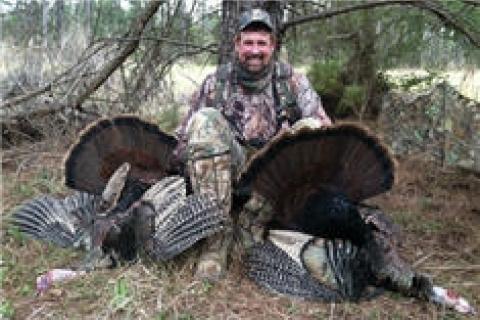
There is no doubt about it that the six more weeks of winter since Groundhog Day has stretched even further into the spring.
As I write this morning from Houston, Texas, the temperature is hovering in the low 40’s. Reports from friends turkey hunting around the country show snow from Montana, Wyoming, the Dakotas to Kansas and Nebraska, with temperatures dipping into the teens in higher elevations. Hardly seems like spring -- and the turkeys, aren’t necessarily gobbling and responding to the call as typically found during this time of year.
 |
| Rob Keck with a Kansas Eastern Rio Hybrid Tom. |
Northeastern States have just opened their spring seasons and many northern tier, mid-western and far western states seasons run until the end of May.
Not only has it been a late spring weather-wise, but vegetation, like leaf-out has been delayed 2 or more weeks and on top of that, turkey flock breakup seems later than I’ve seen in recent memory. Turkeys stayed bunched up, certainly flocked up far later than last spring.
 |
| Florida, Osceloa taken by scattering the flock. |
So what does all this mean for the turkey hunter? In some parts of the country, for some hunters it may have panned out as turkey hunt strategy as normal, but for many, myself included, it showed flocked up and henned up gobblers that in some instances required fall tactics for success, primarily scattering the flock and sitting at the break point using lost calls to call the birds to my gun.
It worked for me in South Florida, South Carolina, Kansas and Missouri where I encountered some huge flocks. In the low country of South Carolina, for example, the afternoon of March 18, three days after the opening of the season, I was with my good friend and long time hunting buddy, Norman Pulliam, when we came upon a flock of 31 hens, 4 jakes and 3 longbeards, stretched out across an old cotton field. Norman asked how are you going to handle this? I told him that when the timing was right, we would separate those three strutters from their girlfriends, I’ve employed this plan numerous times in many states over the last few decades. First, patience is required to observe the direction the flock is heading and waiting to see that stretched out line of hens put a little distance between them and the usually lagging behind strutters.
When I feel there is a separation of 20 to 30 yards between the last hen and the strutters, having positioned myself 100 to 200 yards away, and the flock stretched in front of me, moving right to left, or left to right, I present myself so that the turkeys can see me. I do it slowly and don’t necessarily want the birds to fly, but rather to scurry for the distant cover of the tree line or brush line at the back of the field. I specifically focus on the area where the toms enter the timber and then rush to the spot, immediately sit down and hen yelp.
 |
| Norman and Rob's double. |
In the South Carolina scenario, Norm and I sat down at the base of the same tree at the field’s edge, I did one series of yelps and within 3 minutes, Norman said “I see two white and red heads coming our way.” In less than five minutes from the time we were seated, we doubled on those two longbeards.
 |
| Missouri gobbler with friend Ken Shuler. |
In Missouri, wiht my good friend Ken Shuler, we just walked up on a bunch of birds, a dozen or more hens and two long beards. Coming around the edge of a fescue field we walked into the flock by accident since we had not heard any gobbling for over an hour. When we bumped into the birds, three flew and the rest scattered through the oaks and buckbrush. Ken asked what we should do next. I replied that we were going to sit right where we were as it was the point of the break. That was a spot where an old logging road coming from the creek bottom, winding through the timber, entered the field. I did a series of yelps and almost immediately, I saw a tail fan come out of the buck brush below us, and up the logging road to our hen decoy.
Fall tactics work in the spring! If you encounter bunched up, flocked up turkeys, try to separate or scatter them for success. One thing is for certain though, this year, no matter where you are located, the last week of the season may be some of the very best for calling a gobbler to the call.
- 6461 views

